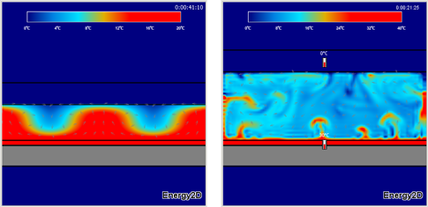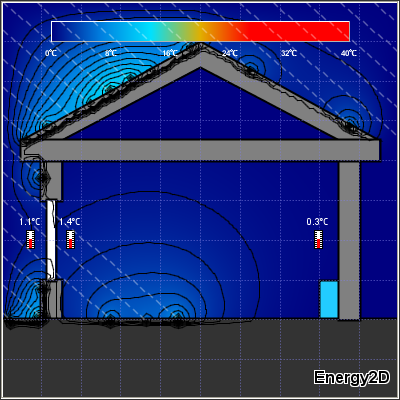Teaching and Learning Heat Transfer with Energy2D
Everyone experiences heat transfer. Indeed, we constantly seek thermal comfort. Because heat transfer is so common in everyday life, one would think that the science and engineering of heat transfer should be easy to teach and learn.

According to the Massachusetts Science and Technology/Engineering Curriculum Framework, published in October 2006, high school students are required to learn thermodynamics and heat transfer in a physics or engineering course. Students are expected to understand that thermal energy is transferred by three different mechanisms: conduction, convection, and radiation. In an engineering course, they are further expected to apply these concepts to analyze and solve problems in real-world thermal systems.

The idea that heat flows from hot to cold may not be difficult to grasp for modern people who live in a thermally controlled environment. Indeed, the fundamental principles of heat transfer and fluid flow were discovered in the 19th century. The hard part is to deepen the conceptual understanding and translate it into problem-solving skills. Most textbooks teach heat transfer as the three separate processes of conduction, convection, and radiation, but in the real world, these processes are often concurrent and intertwined. Reasoning about a thermal phenomenon requires calculations based on a synthesis of knowledge from all three. A hand calculator alone won’t do the trick, however, as the geometric complexity of a thermal system such as an internal combustion engine or a building makes the analysis far too complicated.
Engineering education for the 21st century
Engineering design skills are emphasized in the Massachusetts framework as well. To diagnose a problem and find an optimal solution, students must learn to consider various factors and constraints, make assumptions, design prototypes, conduct experiments, and analyze results. Through this iterative process, the products get better and better. These skills are at the core of the craftsmanship that has propelled our society since the Industrial Revolution.
In the past decades, however, the context of engineering education has changed dramatically. According to the Moving Forward to Improve Engineering Education report, published by the National Science Board in 2007, “Conventional engineering work from conceptual design through manufacturing is increasingly outsourced to countries where the engineering costs are lower. The speed of change means that any set of technical skills may quickly become obsolete. To prosper, U.S. engineers need to provide high value and excel at high-level design, systems integration, innovation, and leadership.”
To help U.S. students compete in a flat world, American schools must reform their curricula and pedagogies to ensure students acquire higher-level skills than their counterparts in lower-cost countries. Cutting-edge educational technologies must be developed and used to modernize classroom experience.
Supported by the National Science Foundation, we are developing a software tool for simulating heat transfer in two dimensions called Energy2D. The software—the result of technology transfer from computational fluid dynamics research to education—is based on fast algorithms for solving the Heat Equation and the Navier-Stokes Equation. Energy2D can simulate conduction and convection for complex 2D structures in real time. This is an important feature that—unlike many simulation tools not explicitly designed for education—allows users to interact with the simulation while it is running and see the results immediately.
Deep roots in science
Since the software is based on fundamental principles in heat and mass transfer, it is able to simulate a large variety of phenomena. Students thus have at their fingertips a powerful computational laboratory for experimentation.

Figure 1 shows two simulations of heat conduction. The first simulation illustrates the concept of thermal bridging. A thermal bridge is created when a conductive piece connects two otherwise insulated pieces, allowing heat to flow through the pathway created. The second simulation shows a comparison of heat conduction through materials with different conductivities. In this setup, heat flows from the top. Two materials are placed in the middle. The left one is 100 times more conductive than the right one. This side-by-side comparison clearly illustrates the effect of insulation using less conductive materials.
Figure 2 shows two simulations of convection between a hot plate at the bottom and a cold plate at the top. Science teachers often use a physical experiment like this to demonstrate thermal convection. Energy2D now presents online simulations that can be used to complement the experiment.
Modeling solar energy
Students in our Engineering Energy Efficiency project will be challenged to design energy-efficient scale model houses that exploit solar power. Hence, it is important to model insolation and radiation. In Energy2D, light particles can be emitted into the simulation box and a ray-tracing method is used to calculate their positions and interactions with other objects. Figure 3 shows a simulation of the solar heating of a simple house.
Virtual sensors
Users can add any number of virtual sensors to a model to record properties at different locations. A virtual thermometer collects temperature data like a data logger. Results from this virtual thermometer can be used to compare with experimental results measured using real temperature sensors. Figure 4 shows the heating and cooling curves produced by two virtual thermometers placed inside two balls with different thermal masses. The results show that the ball with the smaller thermal mass heats up and cools down faster than the one with the greater thermal mass.

Conclusion
Visual learning is crucial in science education, perhaps especially so for today’s students who have grown up with the Internet culture. In the real world, however, heat is invisible to the human eye. Energy2D presents a compelling visualization of temperature distribution and heat flow.
The Energy2D prototype simulations have demonstrated its power in modeling very complex thermal systems. With future enhancements to the computational engine and the user interface, students will have a tool far better than a worksheet for crunching numbers to calculate heat transfer. Just as simulation-based computer-aided design tools are now part of the toolkit for engineers, educational tools such as Energy2D are needed to bring this modern engineering methodology to the classroom.
Charles Xie (qxie@concord.org) is the creator of Energy2D and the director of the Engineering Energy Efficiency project.
Edmund Hazzard (ehazzard@concord.org) is a senior curriculum developer and a green building architect.
